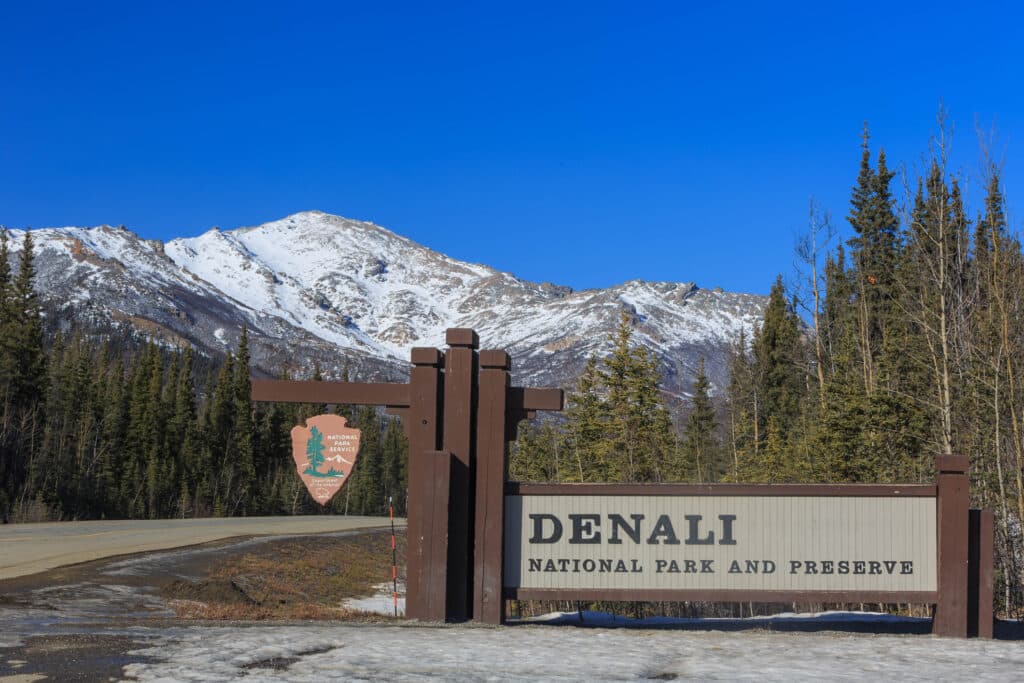
Denali National Park charges a US$15 per person entrance fee for visitors aged 16 and above, which grants access for 7 days. Youth 15 and under enter free, and the fee is collected year-round (unlike some parks, there is no per-vehicle charge). The park honors all U.S. National Park passes: for example, the America the Beautiful annual pass (US$80) covers this park, and Denali also offers its own annual pass for US$45 that admits up to four adults together. Seniors (age 62+) can obtain discounted lifetime or annual passes, and there are free passes available for US military personnel, veterans, fourth-grade students, and visitors with permanent disabilities.
The park itself is open 24 hours a day throughout the year, but operating hours for facilities vary by season – summer (late May through mid-September) is the peak visiting period when most services run full-time. During summer, the Denali Visitor Center is typically open daily (about 8 am to 6 pm), and the 92-mile Park Road is mostly accessible via the park’s bus system. In winter, heavy snow closes the Park Road beyond Mile 3 to public vehicles, and only a small winter visitor center (the Murie Science & Learning Center) remains open on limited hours (approximately 9 am to 4 pm). Seasonal differences are significant: for example, summer bus tours start around May 20 each year and end shortly after Labor Day, whereas from fall until spring the interior of the park can only be accessed on skis, sleds, or snowmobiles. Notably, as of 2025 a major landslide at Pretty Rocks has closed the Park Road past Mile 43 (near Polychrome Pass) until a new bridge is finished – so no buses or cars can reach the western end of the road (Wonder Lake or Kantishna) until at least 2026.
The park’s bus system includes non-narrated shuttle buses and narrated tour buses: the tour bus tickets (such as the popular Tundra Wilderness Tour) automatically include the US$15 park entrance fee in their price, while the cheaper shuttle buses require that each adult passenger buy the entrance pass separately (children 15 and under ride free on shuttles). We visited on 31 July 2025, and all figures were valid then.
Inside Denali National Park: A Complete Visitor’s Companion
What draws people from around the world to Denali National Park? Perhaps it’s the unique combination of unspoiled wilderness, abundant wildlife, and the looming presence of North America’s tallest mountain all in one place. Denali protects over six million acres of subarctic terrain – an area larger than the state of New Hampshire – with just a single 92-mile road penetrating it. The park’s centerpiece is Mount Denali itself (formerly known as Mount McKinley), towering at 20,310 feet.
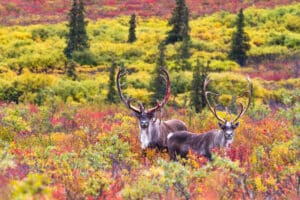
A pair of caribou in Denali national park in Alaska.
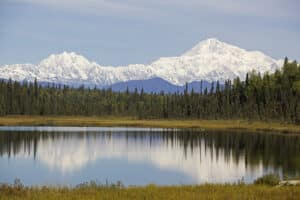
Alaska Denali Mountain
The mountain rises dramatically from the surrounding landscape, and it’s summit is often wrapped in clouds, visible only on rare clear days. Down at lower elevations, the park spans several ecological zones: there are spruce and birch forests (taiga) in the valleys, miles of rolling alpine tundra on the hillsides, and glaciated peaks and icy permafrost terrain in the high country. We were struck by how quickly the scenery changes – driving in, the dense forest gave way to open tundra and then to stark rocky mountains in just a few miles.
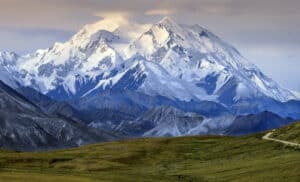
Mount McKinley – Denali National Park – Alaska
Established in 1917 (as Mount McKinley National Park), Denali is one of the older national parks in the United States. It was originally created to protect wildlife (notably Dall sheep, which were being over-hunted at the time) at the urging of conservationists like Charles Sheldon. The park’s boundaries and purpose expanded in 1980 when Congress tripled its size and renamed it Denali National Park and Preserve under the Alaska National Interest Lands Conservation Act (ANILCA). (The name “Denali,” meaning “the high one” in the Koyukon Athabascan language, was officially restored for the park in 1980, and for the mountain itself in 2015). Internationally, Denali was recognized as an UNESCO Biosphere Reserve in 1976 for its global ecological value. Park management focuses on preserving the natural ecosystems – for instance, rangers generally let lightning-sparked wildfires burn in remote areas to maintain the natural cycle, and scientists here study issues like permafrost thaw and its effects on the landscape. We noticed signs detailing how the Pretty Rocks Landslide (a slope destabilized by melting permafrost) is being addressed with a major engineering project. It’s clear that Denali is not only a national treasure but also an outdoor laboratory for understanding subarctic wilderness.
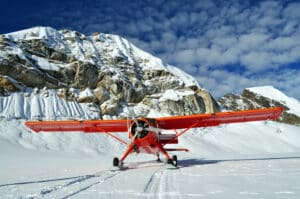
Red plane landing on a Glacier in Denali Mountains
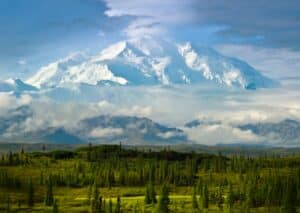
View of Mt McKinley in Denali National Park during summer
Denali’s fauna is famously rich. Visitors hope to glimpse the “Big Five” large mammal species that roam the park: grizzly (brown) bears, moose, caribou, Dall sheep, and wolves. The open terrain along the Park Road makes wildlife sightings common – for example, it’s not unusual to see a grizzly foraging on a distant hillside or a line of caribou crossing the tundra. Beyond the headline mammals, the park sustains over 150 species of birds (from majestic golden eagles to ptarmigan and owls) and dozens of smaller animals like foxes, snowshoe hares, and Arctic ground squirrels. Because hunting is banned inside the park, many of these animals are surprisingly unperturbed by the buses and may appear quite close.
The flora is equally diverse: during our summer visit, tundra slopes were dotted with wildflowers such as fireweed and Arctic lupine, while berry bushes and mushrooms thrived in the damp understory of the forest. There is many ways the park’s ecosystems show resilience – winters are extremely harsh here, but life has adapted to survive under snow and in short intense summers.
A unique aspect of Denali is the relative lack of marked trails once you venture beyond the entrance area. Unlike more developed national parks, Denali encourages a true wilderness experience: visitors are allowed to hike off-trail almost anywhere. In the front-country near the park entrance, however, there are a handful of maintained trails for those who prefer a defined path. For example, the Mount Healy Overlook Trail climbs from the visitor center area, and shorter walks like the Horseshoe Lake Trail or Savage River Loop offer easier introductions to the landscape. The average visitor spends about two to three days here. We’ve learned from experience that a 2- or 3-day stay allows enough time to take a full-day bus tour into the park’s interior and also do a couple of hikes or ranger programs around the entrance. In our case we stayed three nights, and we’re glad we did – it gave us better odds to see the namesake mountain (which finally peeked out of the clouds on our last evening) and to explore at a relaxed pace. For anyone planning a trip, we recommend at least two full days in Denali if possible, given how remote it is.
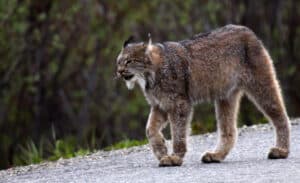
Lynx in Denali National Park.
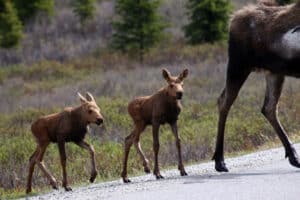
Alaska Moose Babies in Denali National Park
Ever wondered how to maximize your wildlife sightings in Denali? We found that the time of day can make a big difference. Animals tend to be most active in the early morning and late evening when it’s cooler and quieter. On our earliest morning bus, we noticed fewer people on board and found the wildlife more active compared to the middle of the day – exactly what we hoped for. With that in mind, we recommend aiming for one of the first shuttles if you can. Similarly, if you visit in the height of summer, consider going out on a late afternoon tour or staying out near dusk (keeping in mind daylight lasts past 11 pm in June) to catch wildlife when crowds thin out. To avoid the peak-season rush entirely, early September is a great time if your schedule allows: by then, fall colors transform the tundra and most tourists have gone, giving the park a quieter atmosphere (though services are more limited). We definitely recommend planning ahead for the shuttle buses (reserve in advance) but also leaving some unstructured time – wander a bit, attend a sled-dog demo at the kennels, or just sit quietly and watch the landscape. That balance gave us some of our most rewarding moments in Denali.
Top Nearby Places to Visit, Hike & Dine
During our stay, we also explored a few attractions beyond the main park road. There was many short trails near the park entrance, so we decided to try both a challenging hike and a gentle stroll, and we even sampled some local flavors in the surrounding area. Our trip’s highlights included:
-
Mount Healy Overlook Trail: We tackled this steep 4.5-mile round-trip trail that starts near the visitor center. The climb was a workout, but reaching the overlook rewarded us with a sweeping view of the valley and even a faint glimpse of Denali’s snow-capped peak on the horizon when the clouds parted.
-
Savage River Loop: At Mile 15 of the park road (the farthest point you can drive your own car in summer), we took a mellow 2-mile loop trail along the Savage River. This easy riverside walk was a perfect way to stretch our legs after sitting on a bus; the scenery was peaceful, with gray mountains framing the clear stream, and it gave us a taste of the backcountry without straying far from the road.
-
Nenana River Rafting: One afternoon we joined a guided rafting trip on the Nenana River, which forms the eastern boundary of the park. It was an exhilarating ride through glacial waters – we navigated several rapids that splashed cold spray into our faces (waking us right up!). The excursion was beginner-friendly because a guide steered the raft, and it offered a fun, different perspective on Denali’s landscape as we floated between canyon walls just outside the park.
-
49th State Brewing Co (Healy): For dinner one evening, we drove about 15 minutes north to the small town of Healy and ate at this popular local brewery. We tried their signature craft beers and feasted on a couple of enormous bison burgers with fries. The place had a lively atmosphere with a mix of park travelers and seasonal workers, and the hearty meal was just what we needed after a long day of hiking.
-
Black Bear Coffee House: On our last morning, we stopped at this cozy café near the park entrance for breakfast. The coffee here was strong (in a good way) and the fresh cinnamon rolls were gooey and delicious. We relaxed on the porch with our breakfast, chatting with other visitors, and later browsed a nearby gift shop selling local handmade crafts and souvenirs – a nice way to unwind before the long drive back.
After enjoying these side adventures and local spots, we felt that they really rounded out our Denali visit. We didn’t just stay on the tour bus; by hiking, rafting, and spending time in the community, we gained a richer perspective on the area.
Our time in Denali National Park was both inspiring and grounding. By the end of our stay, we had a deeper appreciation for this subarctic wilderness and the efforts to keep it wild. We left with unforgettable memories of mountains and tundra – and a hope that we’ll return one day to experience Denali’s wonders again in a different season.
Sorry, there were no items that matched your criteria.

